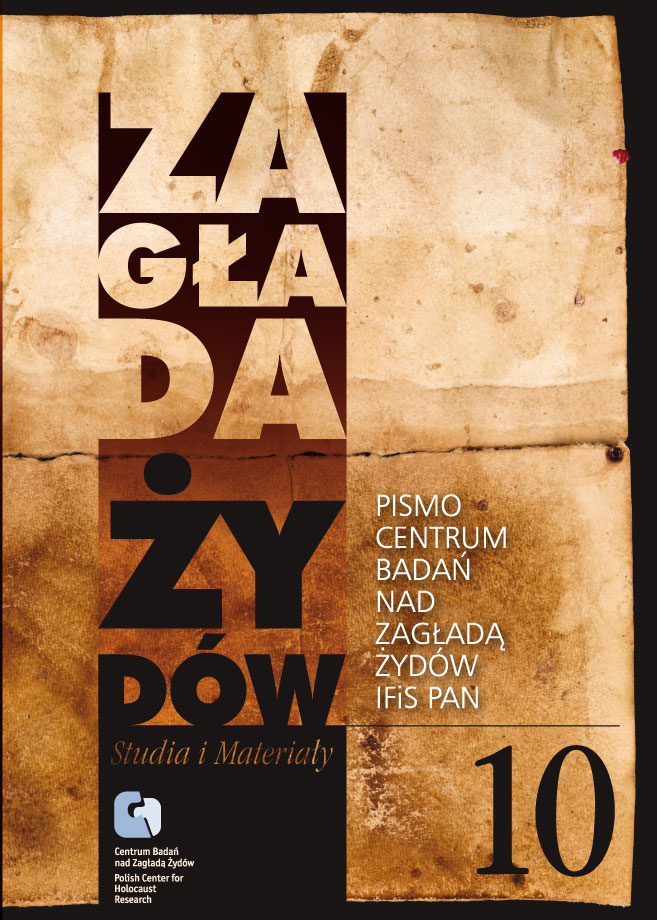Historia krytyczna i jej „gabinet cieni”. Historiografia polska wobec Zagłady 2003–2013
Zagłada Żydów. Studia i Materiały, Nr 10 (2014), Strony: 721-767
Data zgłoszenia: 2020-10-26Data publikacji: 2014-12-01
 https://doi.org/10.32927/ZZSiM.547
https://doi.org/10.32927/ZZSiM.547
Abstrakt
W artykule omawiam najważniejsze zjawiska polskiej historiografii i wybrane publikacje dotyczące Zagłady z lat 2003–2013. W ślad za narratywistami interesuje mnie ich kształt, język, sposób prowadzenia opowieści i użyte metafory.
Po wskazaniu najważniejszych ośrodków naukowych oraz edycji źródeł przechodzę do powstałych w tym czasie monografii obozowych, syntez i opracowań regionalnych, dochodząc do wniosku, że w większości są one pisane bardzo tradycyjnie.
Przełomowy dla historiografii okazał się rok 2000, kiedy ukazali się Sąsiedzi Jana Tomasza Grossa. Przed przejściem do dalekosiężnych konsekwencji tej publikacji omawiam jeszcze pokrótce polemiki wokół innych książek tegoż autora. Ich skutkiem były z jednej strony narodziny historiograficznego „gabinetu cieni” – mobilizacji środowiska skupionego głównie wokół IPN, mającej na celu zdezawuowanie wymowy publikacji Grossa. Z drugiej strony najważniejszą implikacją oferowanego przez Grossa krytycznego myślenia o postawach społeczeństwa polskiego stały się narodziny „nurtu chłopskiego” w historiografii. W książkach Andrzeja Żbikowskiego, Barbary Engelking Jana Grabowskiego czy zbiorowych tomach Prowincja noc i Zarys krajobrazu odmalowane zostały, w sposób zaangażowany i interdyscyplinarny, niechlubne postawy społeczności wiejskiej – denuncjacje, gwałty, a nawet mordowanie Żydów. Wyjątkowe miejsce wśród nich zajmuje wstrząsające świadectwo Tadeusza Markiela. W ramach polityki „gabinetu cieni” kontrofertą dla krytycznego „nurtu chłopskiego” mają być publikacje heroizujące postawy Polaków, podkreślające ich zaangażowanie w ratowanie Żydów, szczególnie wydawane w ramach prowadzonego przez IPN projektu „Index Polaków zamordowanych i represjonowanych za pomoc Żydom w okresie II wojny światowej”.
Na koniec omawiam książki dotyczące nieznanych kart Zagłady w Warszawie, autorstwa Agnieszki Haski, Barbary Engelking i Dariusza Libionki czy tego ostatniego wspólnie z Laurencem Weinbaumem, które nie przynoszą rewolucji w sferze języka, ale poszerzają naszą wiedzę na temat Zagłady. Swoje rozważania zamykam przywołaniem monumentalnej pracy Następstwa zagłady Żydów. Polska 1944–2010, bez której, podobnie jak bez przemyślenia skutków Zagłady w ogóle, nie sposób zrozumieć nas samych i tego, co się wokół nas dzieje.
Słowa kluczowe
Zagłada , historiografia polska , krytyka , metodologia historii , literatura i historia
Licencja
Prawa autorskie (c) 2014 Autor&"Zagłada Żydów. Studia i Materiały"

Utwór dostępny jest na licencji Creative Commons Uznanie autorstwa 4.0 Międzynarodowe.
https://creativecommons.org/licenses/by/4.0
Czasopismo publikowane jest w standardzie Diamond Open Access na licencji CC-BY-4.0 Deed - Uznanie autorstwa 4.0 Międzynarodowa - Creative Commons
Inne teksty tego samego autora
- Bartłomiej Krupa, Critical History and its ‘Shadow Cabinet’. Polish Historiography and the Holocaust during 2003–2013 , Zagłada Żydów. Studia i Materiały: Nr Holocaust Studies and Materials (2017)
- Bartłomiej Krupa, Tomasz Żukowski, Pod presją. Co mówią o Zagładzie ci, którym odbieramy głos [Bartłomiej Krupa] , Zagłada Żydów. Studia i Materiały: Nr 17 (2021)
- Bartłomiej Krupa, Piotr Krupiński, „Dlaczego gęsi krzyczały?” Zwierzęta i Zagłada w literaturze polskiej XX i XXI wieku, Warszawa: Wydawnictwo IBL PAN, 2016, 35 6 s. , Zagłada Żydów. Studia i Materiały: Nr 13 (2017)
- Bartłomiej Krupa, O nieobecności Zagłady, czyli czytanie Rozmów z katem Kazimierza Moczarskiego , Zagłada Żydów. Studia i Materiały: Nr 7 (2011)
- Bartłomiej Krupa, Jerzy Kwiatkowski, 485 dni na Majdanku, Lublin: Państwowe Muzeum na Majdanku, 2018, 440 s. , Zagłada Żydów. Studia i Materiały: Nr 14 (2018)
- Bartłomiej Krupa, Stanisław Gombiński (Jan Mawult), Wspomnienia policjanta z warszawskiego getta, red. i wprowadzenie Marta Janczewska, Warszawa: Stowarzyszenie Centrum Badań nad Zagładą Żydów i Żydowski Instytut Historyczny, 2010, 282 s. , Zagłada Żydów. Studia i Materiały: Nr 7 (2011)
- Bartłomiej Krupa, Karolina Koprowska, Postronni? Zagłada w relacjach chłopskich świadków, Kraków: Universitas, 2018, 210 s. , Zagłada Żydów. Studia i Materiały: Nr 15 (2019)
- Bartłomiej Krupa, Mietek Pachter, „Umierać też trzeba umieć” , Zagłada Żydów. Studia i Materiały: Nr 12 (2016)
Podobne artykuły
- Dariusz Libionka, Jacek Leociak, 75. rocznica akcji „Reinhardt” , Zagłada Żydów. Studia i Materiały: Nr 13 (2017)
- Bartłomiej Krupa, Critical History and its ‘Shadow Cabinet’. Polish Historiography and the Holocaust during 2003–2013 , Zagłada Żydów. Studia i Materiały: Nr Holocaust Studies and Materials (2017)
- Jacek Leociak, Adam Mazur, Artur Żmijewski, „Berek jest głosem o niemocy wobec okrucieństwa; pragnieniem, by Zagłada się nie wydarzyła”. Z Arturem Żmijewskim rozmawiają Jacek Leociak i Adam Mazur , Zagłada Żydów. Studia i Materiały: Nr 17 (2021)
- Jacek Leociak, Literature of the Personal Document as a Source in Holocaust Research (a Methodological Reconnaissance). , Zagłada Żydów. Studia i Materiały: 2008: Holocaust Studies and Materials
- Jan Tomasz Gross, Czy Zagłada jest ich historią, czy naszą? (Plaidoyer w przedmiocie ustanowienia w Polsce miejsca pamięci poświęconego Zagładzie) , Zagłada Żydów. Studia i Materiały: Nr 13 (2017)
- Anna Wylegała, Niezauważony potencjał? Historia mówiona w polskich badaniach nad Zagładą , Zagłada Żydów. Studia i Materiały: Nr 20 (2024)
- Justyna Kowalska-Leder, Literatura polska ostatniego dziesięciolecia wobec Zagłady – próby odpowiedzi na nowe wzywania , Zagłada Żydów. Studia i Materiały: Nr 10 (2014)
- Jacek Leociak, Zagłada w „Muzeum życia” (Muzeum Polin i jego kłopoty z muranowskim genius loci) , Zagłada Żydów. Studia i Materiały: Nr 11 (2015)
- Jacek Leociak, Literatura dokumentu osobistego jako źródło do badań nad Zagładą Żydów (Rekonesans metodologiczny) , Zagłada Żydów. Studia i Materiały: Nr 1 (2005)
- Bożena Szaynok, Zatrzymane w archiwach. Wojewódzki Urząd Kontroli Prasy, Publikacji i Widowisk w Poznaniu wobec tematyki żydowskiej na łamach czasopism katolickich (1945–1950) , Zagłada Żydów. Studia i Materiały: Nr 15 (2019)
1 2 3 4 5 6 7 8 9 10 11 12 13 14 15 16 17 18 19 20 21 22 23 24 25 26 27 28 29 30 31 32 33 34 35 36 37 38 39 40 41 42 43 44 45 46 47 48 49 50 > >>
Możesz również Rozpocznij zaawansowane wyszukiwanie podobieństw dla tego artykułu.
 English
English
 Język Polski
Język Polski



 https://orcid.org/0000-0002-9003-4225
https://orcid.org/0000-0002-9003-4225

